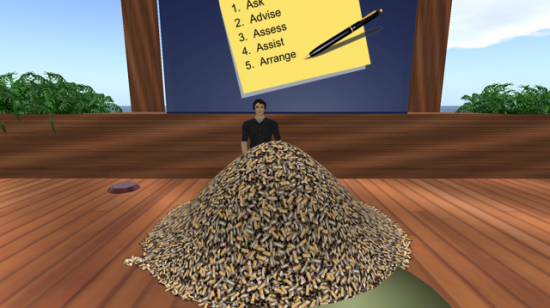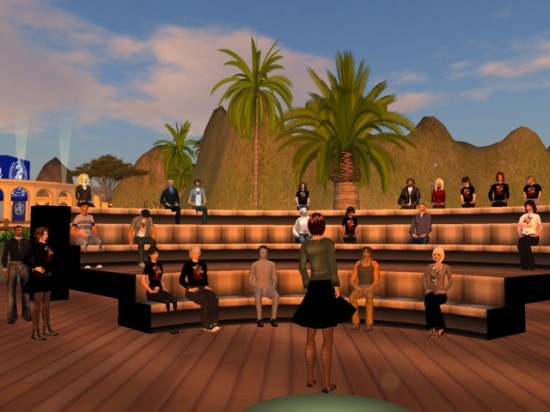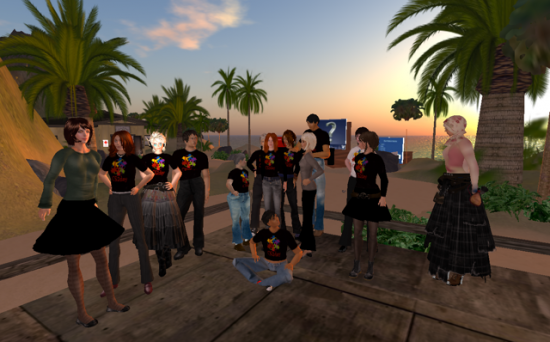Over the last three years I’ve planned, designed, and orchestrated a dozen learning events in the virtual world of Second Life.
I’ve been fortunate enough to work with extremely experienced and talented programmers, producers, content experts, scripters, and machinima artists from whom I have learned volumes about planning and staging successful learning events.
As I reflect on these experiences, I’ve drawn up a list of the top eleven — ten seemed so predictable — most important lessons I’ve learned.
1. Prepare them just enough — and no more
As with most virtual worlds, Second Life is chock-a-block full of intriguing possibilities. You can fly, build, photograph, gesture, control the time of day! In addition to all that, the interface is rich and complex and there is always more than one way to accomplish any task.
So it’s tempting, when first introducing someone to a virtual world, to show them everything – or to show them just one more really cool skill as it might be the tipping point to infect them with your own enthusiasm.
However, I have finally learned to resist that temptation.
Most people can’t absorb tons of information in one sitting. I know that I didn’t – why should I expect that others will?
Plus, there’s another reason. When the event is over, the attendees will look back at the experience and if the preparation session for the event was more intensive than the learning they received from the event itself, they will consider the event a failure.
Today, our pre-event training regimes include only those skills the learners will need in order to participate in the event and no more.
2. Set learning goals upfront and use them as a filter
In the early planning stages, work with your content experts and the program sponsor to establish a short and well-defined list of learning goals.
What is it that you want your learners to exit the program knowing?
That list will serve the team well in many ways. It will drive decisions about how to spend money — will that fun simulation help you meet the learning goals? — clarify how to allocate time on the agenda, and serve as a filter when the inevitable “mission creep†begins.
3. Make sure your back up plan has a back up plan
The old saying really is true, if it can go wrong, it will.
I have seen so many “unexpected†problems crop up in every event I’ve been a part of – sound problems, connectivity hassles, access issues, electrical problems, region shut-downs, you name it.
It seems obvious, but the very best way to avoid these inevitable glitches ruining your event is to anticipate them and have a plan in place to address each one. For example, it’s good to have phone numbers or Skype IDs for all learner participants — if they have sound problems, you can always Skype them in.
4. The power of two facilitators
Our learning events always include a content expert who has worked with us to develop the session’s content and then, typically, serve the lecturer or facilitator role.
But we now recommend two facilitators.
Hopefully you can line up colleagues who are used to working together, but it can work equally well with experts who you bring together for the cause.
Why two? It’s helpful for the learner to hear two perspectives, two voices and it improves the event’s flow to hand-off one to the other.
And, just as importantly, while one is speaking or leading, the other can monitor local chat, provide feedback, and address content questions that arise. If the instructional design calls for small group work, then you instantly have two small group leaders — voila!
They also serve as back-ups for each other — if one is having sound problems, the other can pinch hit.
5. Measure twice, cut once
That age-old seamstress mantra totally applies to virtual learning events.
There is just no substitute for rehearsals where you go through your program to work out all the kinks.
Run your facilitators, producers, and other program staff through at least one full rehearsal, preferably two.
If the calendar doesn’t permit time for two full rehearsals, then opt for a “blocking†rehearsal. That is, rehearse all the transitions, without the intervening content — that is, practice the parts when people come on, go off, and all the movements and changes.
6. Answer the question ‘Why are we doing this in a virtual world?’ — Â before it gets asked
No doubt about it, conducting learning events in virtual worlds — any virtual world — is a lot of work for the sponsor, the producers, and for the learners.
So it only makes sense to use virtual world technology if you are making use of its unique affordances. That is, if you are doing things that can only be done in a virtual world.
If you bring your learners into a beautiful virtual environment and then talk at them with a PowerPoint deck for an hour, everyone will leave feeling cheated.
Instead, make it work for you. Devise a simulation, do some role playing, leverage some whimsy, do some collaborative building, defy the laws of physics – make it clear why you have all gone to the trouble to be there.

7. Experienced technical support producers are essential
In addition to your upfront investment in learner training, participants will need technical support on the day of the event.
Count on it.
The presence of experienced, calm, and professional technical support — we call them “producers†— is a must.
Did I say “calm� Let me say it again. Calm.
My preferred ratio is one producer for every eight new learners.
Make sure you have a private back-chat channel open, such as instant messaging, group chat, or Skype, for the producers to strategize, share, and hand-off among themselves.
Consider asking the learners to come 15-20 minutes early in order to troubleshoot any pesky technical issues before the event gets underway — not all will be able to, but those who do will be taken care of, freeing your producers to focus on the just-on-time or late arrivals.
Have your producers wear a “Ask Me for Tech Help†label on their avatar.
8. Consider venue design carefully
After playing with a number of event location design options, I’ve gravitated to the simplest possible.
Our events typically have outdoor seating — no doorways to navigate, no walls to bump into, and no ceilings to hinder the view — with very large and simple visuals to avoid view problems.
I tend toward natural-looking scenes — a few trees, open sky, and a blue-water view — with very little visual clutter.
But, of course, you also want the design to reflect and support the content of your event. Design your seating with automatic sit upon clicking and encourage all participants to be seated as soon as they arrive, which helps to calm things down.
Landscape simplicity also helps to keep the prim count low to reduce the processing load.

9. Document everything as you go
I am continually amazed by how quickly I forget useful things.
Who attended? What was the plan? How much did we rehearse? How long did it take? What happened in local chat?
Keep a record of it all, including a blog post or two — like this one! — to sum up your major take-home lessons. You’ll be glad you did when the planning for the next event begins.
10. Don’t forget to assess
It is important to find a way to build evaluation into your learning plan.
Often, we get so caught up in the work of producing the event, we forget to gather feedback from the learners when it’s over.
Even if it’s just a short questionnaire, provided as a link, at the end of the session, find a way for your learners to tell you honestly what worked — and didn’t work — for them.
You might also consider gathering similar feedback from the facilitators and producers. They often catch glitches that you might miss.
11. Find a way to make it fun
One of the things we all love about virtual worlds is that touch of fantasy about them.
Even though it may be important for your event to project a serious and professional tone, your learners are sure to enjoy at least one touch of whimsy somewhere in the program — we typically do this on a break or at the end.
It could be something as simple as some virtual food and drink, served up to your guests. Maybe an automatic dance floor for everyone to trip the light fantastic? Fireworks are always fun.
And a simple T-shirt emblazoned with your company or program logo, given to each avatar at the end of the session can be a surprising hit.

- 11 tips for successful virtual training - August 18, 2011
